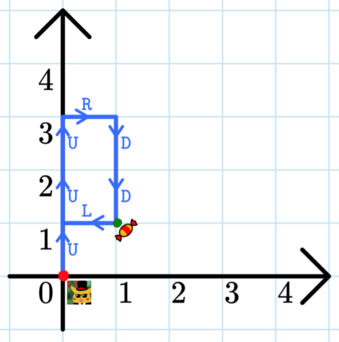CF1791B.Following Directions
普及/提高-
通过率:0%
AC君温馨提醒
该题目为【codeforces】题库的题目,您提交的代码将被提交至codeforces进行远程评测,并由ACGO抓取测评结果后进行展示。由于远程测评的测评机由其他平台提供,我们无法保证该服务的稳定性,若提交后无反应,请等待一段时间后再进行重试。
题目描述
Alperen is standing at the point (0,0) . He is given a string s of length n and performs n moves. The i -th move is as follows:
-
if si=L , then move one unit left;
-
if si=R , then move one unit right;
-
if si=U , then move one unit up;
-
if si=D , then move one unit down.
 If Alperen starts at the center point, he can make the four moves shown. There is a candy at (1,1) (that is, one unit above and one unit to the right of Alperen's starting point). You need to determine if Alperen ever passes the candy.
If Alperen starts at the center point, he can make the four moves shown. There is a candy at (1,1) (that is, one unit above and one unit to the right of Alperen's starting point). You need to determine if Alperen ever passes the candy.  Alperen's path in the first test case.
Alperen's path in the first test case.
输入格式
The first line of the input contains an integer t ( 1≤t≤1000 ) — the number of testcases.
The first line of each test case contains an integer n ( 1≤n≤50 ) — the length of the string.
The second line of each test case contains a string s of length n consisting of characters L , R , D , and U , denoting the moves Alperen makes.
输出格式
For each test case, output "YES" (without quotes) if Alperen passes the candy, and "NO" (without quotes) otherwise.
You can output the answer in any case (for example, the strings "yEs", "yes", "Yes" and "YES" will be recognized as a positive answer).
输入输出样例
输入#1
7 7 UUURDDL 2 UR 8 RRRUUDDD 3 LLL 4 DUUR 5 RUDLL 11 LLLLDDRUDRD
输出#1
YES YES NO NO YES YES NO
说明/提示
In the first test case, Alperen follows the path
(0,0)→U(0,1)→U(0,2)→U(0,3)→R(1,3)→D(1,2)→D(1,1)→L(0,1).
Note that Alperen doesn't need to end at the candy's location of (1,1), he just needs to pass it at some point.
In the second test case, Alperen follows the path
(0,0)→U(0,1)→R(1,1).
In the third test case, Alperen follows the path
(0,0)→R(1,0)→R(2,0)→R(3,0)→U(3,1)→U(3,2)→D(3,1)→D(3,0)→D(3,−1).
In the fourth test case, Alperen follows the path
(0,0)→L(−1,0)→L(−2,0)→L(−3,0).